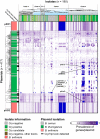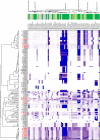Lineage-specific plasmid acquisition and the evolution of specialized pathogens in Bacillus thuringiensis and the Bacillus cereus group
- PMID: 29509989
- PMCID: PMC5947300
- DOI: 10.1111/mec.14546
Lineage-specific plasmid acquisition and the evolution of specialized pathogens in Bacillus thuringiensis and the Bacillus cereus group
Abstract
Bacterial plasmids can vary from small selfish genetic elements to large autonomous replicons that constitute a significant proportion of total cellular DNA. By conferring novel function to the cell, plasmids may facilitate evolution but their mobility may be opposed by co-evolutionary relationships with chromosomes or encouraged via the infectious sharing of genes encoding public goods. Here, we explore these hypotheses through large-scale examination of the association between plasmids and chromosomal DNA in the phenotypically diverse Bacillus cereus group. This complex group is rich in plasmids, many of which encode essential virulence factors (Cry toxins) that are known public goods. We characterized population genomic structure, gene content and plasmid distribution to investigate the role of mobile elements in diversification. We analysed coding sequence within the core and accessory genome of 190 B. cereus group isolates, including 23 novel sequences and genes from 410 reference plasmid genomes. While cry genes were widely distributed, those with invertebrate toxicity were predominantly associated with one sequence cluster (clade 2) and phenotypically defined Bacillus thuringiensis. Cry toxin plasmids in clade 2 showed evidence of recent horizontal transfer and variable gene content, a pattern of plasmid segregation consistent with transfer during infectious cooperation. Nevertheless, comparison between clades suggests that co-evolutionary interactions may drive association between plasmids and chromosomes and limit wider transfer of key virulence traits. Proliferation of successful plasmid and chromosome combinations is a feature of specialized pathogens with characteristic niches (Bacillus anthracis, B. thuringiensis) and has occurred multiple times in the B. cereus group.
Keywords: Bacillus cereus; Bacillus thuringiensis; insecticidal toxins; mobile genetic elements; pan-genome.
© 2018 The Authors. Molecular Ecology Published by John Wiley & Sons Ltd.
Figures





Similar articles
-
Comparative Genomics of Bacillus thuringiensis Reveals a Path to Specialized Exploitation of Multiple Invertebrate Hosts.mBio. 2017 Aug 8;8(4):e00822-17. doi: 10.1128/mBio.00822-17. mBio. 2017. PMID: 28790205 Free PMC article.
-
Transfer of Bacillus thuringiensis plasmids coding for delta-endotoxin among strains of B. thuringiensis and B. cereus.Proc Natl Acad Sci U S A. 1982 Nov;79(22):6951-5. doi: 10.1073/pnas.79.22.6951. Proc Natl Acad Sci U S A. 1982. PMID: 6294667 Free PMC article.
-
High instability of a nematicidal Cry toxin plasmid in Bacillus thuringiensis.J Invertebr Pathol. 2016 Jan;133:34-40. doi: 10.1016/j.jip.2015.11.009. Epub 2015 Nov 22. J Invertebr Pathol. 2016. PMID: 26592941
-
Sporulation and delta-endotoxin synthesis by Bacillus thuringiensis.Cell Mol Life Sci. 2002 Mar;59(3):417-25. doi: 10.1007/s00018-002-8434-6. Cell Mol Life Sci. 2002. PMID: 11964120 Free PMC article. Review.
-
What sets Bacillus anthracis apart from other Bacillus species?Annu Rev Microbiol. 2009;63:451-76. doi: 10.1146/annurev.micro.091208.073255. Annu Rev Microbiol. 2009. PMID: 19514852 Review.
Cited by
-
Pathogenicity and Genomic Characterization of a Novel Genospecies, Bacillus shihchuchen, of the Bacillus cereus Group Isolated from Chinese Softshell Turtle (Pelodiscus sinensis).Int J Mol Sci. 2023 Jun 1;24(11):9636. doi: 10.3390/ijms24119636. Int J Mol Sci. 2023. PMID: 37298593 Free PMC article.
-
Bacillus wiedmannii biovar thuringiensis: A Specialized Mosquitocidal Pathogen with Plasmids from Diverse Origins.Genome Biol Evol. 2018 Oct 1;10(10):2823-2833. doi: 10.1093/gbe/evy211. Genome Biol Evol. 2018. PMID: 30285095 Free PMC article.
-
Diversity of the Rap-Phr quorum-sensing systems in the Bacillus cereus group.Curr Genet. 2019 Dec;65(6):1367-1381. doi: 10.1007/s00294-019-00993-9. Epub 2019 May 18. Curr Genet. 2019. PMID: 31104082
-
Bacteria from natural populations transfer plasmids mostly towards their kin.Proc Biol Sci. 2019 Jun 26;286(1905):20191110. doi: 10.1098/rspb.2019.1110. Epub 2019 Jun 26. Proc Biol Sci. 2019. PMID: 31238848 Free PMC article.
-
The Distribution of Several Genomic Virulence Determinants Does Not Corroborate the Established Serotyping Classification of Bacillus thuringiensis.Int J Mol Sci. 2021 Feb 24;22(5):2244. doi: 10.3390/ijms22052244. Int J Mol Sci. 2021. PMID: 33668147 Free PMC article.
References
-
- Altschul, S. F. , Gish, W. , Miller, W. , Myers, E. W. , & Lipman, D. J. (1990). Basic local alignment search tool. Journal of Molecular Biology, 215, 403–410. https://doi.org/10.1016/S0022-2836(05)80360-2 - DOI - PubMed
-
- Antonation, K. S. , Grutzmacher, K. , Dupke, S. , Mabon, P. , Zimmermann, F. , Lankester, F. , … de Nys, H. M. (2016). Bacillus cereus biovar anthracis causing anthrax in sub‐saharan Africa‐chromosomal monophyly and broad geographic distribution. PLoS Neglected Tropical Diseases, 10, e0004923. - PMC - PubMed
-
- Aziz, R. K. , Bartels, D. , Best, A. A. , DeJongh, M. , Disz, T. , Edwards, R. A. , … Meyer, F. (2008). The RAST Server: Rapid annotations using subsystems technology. BMC Genomics, 9, 75 https://doi.org/10.1186/1471-2164-9-75 - DOI - PMC - PubMed
-
- Berry, C. , O'Neil, S. , Ben‐Dov, E. , Jones, A. F. , Murphy, L. , Quail, M. A. , … Parkhill, J. (2002). Complete sequence and organization of pBtoxis the toxin‐coding plasmid of Bacillus thuringiensis subsp. israelensis . Applied and Environment Microbiology, 68, 5082–5095. https://doi.org/10.1128/AEM.68.10.5082-5095.2002 - DOI - PMC - PubMed
Publication types
MeSH terms
Substances
Grants and funding
LinkOut - more resources
Full Text Sources
Other Literature Sources
Molecular Biology Databases

